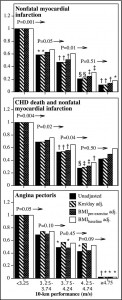THANK YOU FOR VISITING SWEATSCIENCE.COM!
My new Sweat Science columns are being published at www.outsideonline.com/sweatscience. Also check out my new book, THE EXPLORER'S GENE: Why We Seek Big Challenges, New Flavors, and the Blank Spots on the Map, published in March 2025.
- Alex Hutchinson (@sweatscience)
***
A new study that just appeared online in the American Journal of Epidemiology (abstract here, press release here) adds to the evidence that spending most of the day sitting down has bad effects that aren’t cancelled by daily workouts at the gym. The study looked at 123,000 men and women between 1993 and 2006:
Women who reported more than six hours per day of sitting were 37 percent more likely to die during the time period studied than those who sat fewer than 3 hours a day. Men who sat more than 6 hours a day were 18 percent more likely to die than those who sat fewer than 3 hours per day. The association remained virtually unchanged after adjusting for physical activity level.
It’s that last bit that stings. The obvious question is: how much exercise did the subjects do? In their analysis, the category for “most active” was those who got more than 52.5 MET-hours per week of physical activity (including both day-to-day chores and exercise). According to the ACSM’s Compendium of Physical Activities, running burns anywhere from 7 METs (for “jogging”) to 18 METs (at 5:30/mile). Still, it suggests that the most active people in the study were doing the equivalent of almost an hour a day of jogging, which isn’t insignificant. And the lack of change with respect to physical activity (except at the very lowest level) doesn’t give us much reason to hope that just a bit more exercise — say 100 MET-hours per week — would be any different (though clearly this is a question that should be explored by future studies).
A similar study was covered a few weeks ago by Gretchen Reynolds, and another related study made news back in January, so clearly this result isn’t a one-time fluke. (Interestingly, the study reported by Reynolds focused on men, while the new study found a bigger effect in women — so no one’s immune!) As a committed desk jockey, this is somewhat worrying to me. I’m not quite sure what to do about it. Maybe those standing-desk people aren’t so crazy after all…

